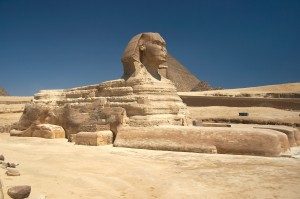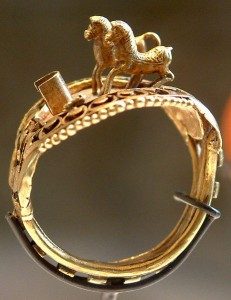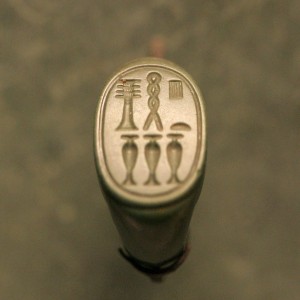‘Is it not beautiful to know the reason for things?’
My father always had fun telling me why the last button was used on the detached vest, or why the fish knife blade was the shape of a shovel. Today I will tell you some of the ancient origins and uses of the gold ring. Let’s travel back to the time of the Gold rings of Ancient Egypt.
In prehistory, the ring already had deep meaning. More than just an emblem of wealth, the ring was used by our ancestors to identify the person with whom life was shared; hunting, planting, living, etc. This person could be a life partner or a partner in the working community. The chosen motives were in close relation with the religious beliefs of the time. The materials were intrinsically linked to the prehistoric creeds which in turn were directly related to the activities that allowed the community to sustain itself.

The Sphinx
The role of the well-defined ring comes from ancient Egypt. Egyptian rings have been discovered that date back to about 3000 years before the Christian era. The ring was used as an ornament more than 30 centuries before the beginning of our time.
From this era, beautiful, stylised solid gold rings have been found. Often in their form, we see recurrent symbols: vipers, scorpions and other animals that produce fear or repulsion. This is because rings were used as talismans or amulets – as well as symbols of power and wealth – and were intended to protect its user from any hostile, harmful or mysterious force.
Beetles, cats and hawks were used by the Egyptians as protection against adversaries and various evils, as they represented the heads of the most powerful gods in their religious beliefs.
There were also rings of geometric forms, using symbols with the intention of protecting the wearer: for example the eye of Wedjet (against the evil eye), the Djed ( representing stability), Sa, Ankl and Tyer (health, prosperity, long life and luck).
Colours played an important role
Colour had a precise symbolism and depending on this, a stone was chosen. Green, for example, represented vegetation, black- fertile land, red was used to symbolise the desert, etc.

Ring of Ramses II curtesy- Louvre Museum
The most representative function of the ring in ancient Egypt was to accompany its user to “the afterlife“, aka life after death. According to ancient religious and literary texts, the gods were incarnated in three substances: their bones of Silver, their flesh of Gold and their heads of Lapis Lazuli. The tombs found, abound with rings of silver, gold, iron, enamelled clay or Quartz. These rings were worn by both men and women, either in the form of protective ornament, to demonstrate authority or to carry the family seal. The rings of the less wealthy families, as well as those worn by the dead servants who accompanied their patrons on their last voyage, were simple, copper, or pottery. The noble and wealthy wore true gold and silver jewellery. Each ring was a masterpiece of the goldsmith of the time, chiselled and embossed in relief.
Many of these rings had hieroglyphs engravings with the names and titles of their owners. Beautiful examples of this type have been found made of Ivory, Amber, and precious stones such as Carnelian, Lapis Lazuli or Onyx.
A recurrent image in all rings of the dead, independent of its material, is the beetle aka Scarab. This insect was a symbol of good luck and evoked the God Jepri, who was depicted with a man’s body and beetle head. Jepri was the god of the morning and the symbol of eternal life. According to the religious beliefs of ancient Egypt, wearing a ring with the beetle (a Scarab) was considered an indispensable tool in approaching Osiris, the deity who presided over the tribunals of the deceased.

A Scarab ring used as a seal in Ancient Egypt
It should also be noted that throughout the ancient times these rings were used as seals, the Egyptians were the precursors of this form of a notary. We know that they adopted Mesopotamian style cylinders used as seals, incorporating them into rings. They signed their documents by lightly pressing the seal of clay, gypsum or earth so that their seal would be recognised in for legal documents. These rings were made of carved metal or carved stones such as Carnelian, Diorite or Agate. Enamelled clay was also used, the base having an inscription and hieroglyph engraved in the hollow.
And the other important use of the rings in ancient Egypt, which has been passed down through the centuries, is its emblematic function: the Egyptian husband places the ring on his wife’s finger in order to entrust him with the custody of the home and Their Possessions. Such is the history of the famous “wedding rings”.
Come on over to Rocks & Co and explore the centuries-old passion that is the ring!






